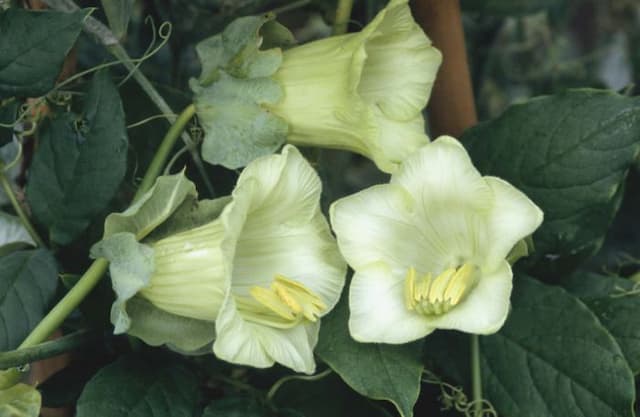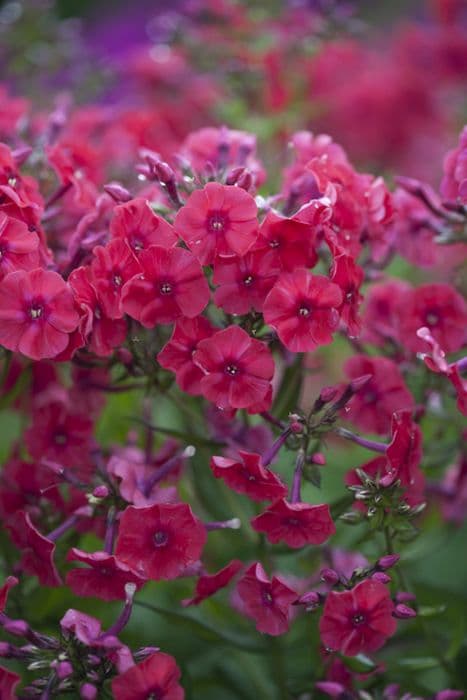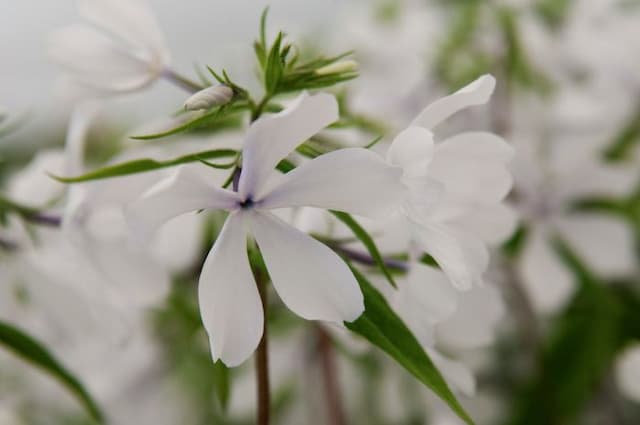Garden Phlox Phlox paniculata 'Amethyst' Foerster

ABOUT
Phlox paniculata 'Amethyst' Foerster, commonly known as garden phlox, is a perennial plant renowned for its striking floral display. It produces lush clusters of fragrant flowers that have a vibrant amethyst color, which can add a rich, jewel-toned hue to any garden space. The blooms are arranged in panicle-like structures that sit atop sturdy green stems, surrounded by vibrant green foliage. The leaves of the garden phlox are pointed and oval-shaped, providing a lush backdrop that complements the vivid blooms. The flowering period typically occurs in summer, during which time the plant becomes a hub of activity for pollinators such as butterflies and hummingbirds, attracted by the nectar-rich blooms. The combination of the plant’s colorful flowers and aromatic scent makes it a popular choice among gardeners looking to add both visual and olfactory interest to their gardens.
About this plant
 Names
NamesFamily
Polemoniaceae
Synonyms
Garden Phlox, Summer Phlox, Perennial Phlox, Tall Phlox
Common names
Phlox paniculata 'Amethyst' Foerster.
 Toxicity
ToxicityTo humans
Garden Phlox is generally considered non-toxic to humans. Ingesting any part of the plant typically does not result in serious poisoning. However, sensitivity can vary among individuals, and consuming large quantities could potentially cause stomach upset or discomfort. If a person is known to have sensitivity to this plant or if any adverse reaction is observed after handling or ingesting it, medical advice should be sought.
To pets
Garden Phlox is also generally considered non-toxic to pets like dogs and cats. It is not known to cause serious harm if animals ingest parts of the plant. However, individual animals may have different sensitivities, and consumption could lead to mild gastrointestinal upset in certain cases. If a pet displays signs of distress after consuming the plant, it is advisable to consult a veterinarian.
 Characteristics
CharacteristicsLife cycle
Perennials
Foliage type
Deciduous
Color of leaves
Green
Flower color
Purple
Height
2-4 feet [60-120 cm]
Spread
1-3 feet [30-90 cm]
Plant type
Herb
Hardiness zones
4
Native area
North America
Benefits
 General Benefits
General Benefits- Attracts Pollinators: Phlox paniculata 'Amethyst' Foerster is known for its ability to attract bees, butterflies, and other pollinating insects, which is beneficial for the garden ecosystem.
- Aesthetic Appeal: With its vivid purple flowers and pleasant fragrance, it adds a splash of color and a sensory dimension to gardens and landscapes.
- Ease of Growth: It is relatively easy to cultivate in a range of garden conditions, requiring minimal maintenance once established.
- Drought Tolerance: Once established, this variety of garden phlox can tolerate periods of drought, making it suitable for gardens in drier climates.
- Seasonal Interest: It flowers in mid to late summer, providing color and interest during a time when many other plants may have finished blooming.
- Wildlife Friendly: It offers nectar and habitat for wildlife, contributing to biodiversity within the garden setting.
- Cut Flower Use: The blooms make excellent cut flowers, allowing for beautiful arrangements inside the home.
- Border Planting: It serves well as a border plant, with its clumping growth habit creating defined edges in garden designs.
 Medical Properties
Medical PropertiesThis plant is not used for medical purposes.
 Air-purifying Qualities
Air-purifying QualitiesThis plant is not specifically known for air purifying qualities.
 Other Uses
Other Uses- Phlox paniculata 'Amethyst' can be used as a natural dye, producing shades of pink and purple depending on the mordant used.
- It can serve as a visual attractant in vegetable gardens to lure pollinators, thus increasing the yield of crops.
- The plant's clumps can be effective in controlling soil erosion in sloped gardens or areas prone to runoff.
- Garden Phlox can be planted in pots and moved around to create dynamic garden designs or to fill in as temporary ground cover.
- The tall stems can be used in creating natural trellises for climbing plants when they become woody after the season ends.
- The flower heads can be used in crafts, such as making floral wreaths or pressed flower art due to their vibrant colors.
- Used in educational settings, Garden Phlox can be an example to teach about native plant species and the importance of biodiversity.
- The dense foliage can provide a habitat for beneficial insects, including predatory ones that help control garden pests.
- Phlox paniculata 'Amethyst' might be used in sensory gardens for its texture and soft, frilly flowers that offer tactile stimulation.
- Garden Phlox can be strategically placed to create a color-themed garden area, such as a purple corner, to offer a visually stunning experience.
Interesting Facts
 Feng Shui
Feng ShuiThe Garden Phlox is not used in Feng Shui practice.
 Zodiac Sign Compitability
Zodiac Sign CompitabilityThe Garden Phlox is not used in astrology practice.
 Plant Symbolism
Plant Symbolism- Harmony and Unity: The clustered flowers of the garden phlox symbolize the unity and harmony in bringing together many parts into one whole.
- Agreement: Often used in bouquets to express consensus or the mutual understanding between people.
- Proposal of Love: Garden phlox can represent a proposal or the offering of one's heart to another.
- Sweet Dreams: In the language of flowers, phlox is associated with the sentiment of wishing someone sweet dreams or a peaceful sleep.
 Water
WaterGarden Phlox should be watered deeply, allowing the water to penetrate the soil to a depth of at least an inch. This is best done once a week to encourage deep root growth, although you may need to water more frequently during particularly hot or dry periods. A good rule of thumb is to provide about one gallon of water per square foot every week. Be careful to avoid overhead watering to minimize the risk of powdery mildew developing on the leaves, instead focus on targeting the water at the base of the plant.
 Light
LightGarden Phlox thrives in a location that receives full sunlight for at least six hours a day. Ideal planting spots are sunny borders or open areas that are not overshadowed by taller plants or structures. They can tolerate partial shade, but too little light can result in weaker stems and fewer blooms.
 Temperature
TemperatureGarden Phlox prefers a temperate climate and will bloom best when daytime temperatures are between 65°F and 85°F. It's a hardy plant that can survive temperature dips down to about -30°F, although blooming might be affected if temperatures exceed 90°F during the heat of summer.
 Pruning
PruningGarden Phlox benefits from pruning to encourage bushier growth and more blooms. It should be pruned in early spring before new growth starts. Deadheading, or removing spent flowers, throughout the blooming season can also encourage more flowers. After the first killing frost, cut the stems back to about one or two inches above the ground to prepare for winter.
 Cleaning
CleaningAs needed
 Soil
SoilGarden Phlox thrives in a soil mix that is well-draining yet retains moisture, composed of loamy soil enriched with organic matter such as compost or peat moss, with a pH range from 6.0 to 8.0, which is slightly acidic to mildly alkaline.
 Repotting
RepottingGarden Phlox, being a perennial garden plant, does not require frequent repotting and is typically not repotted as it is grown in the ground rather than containers.
 Humidity & Misting
Humidity & MistingGarden Phlox does not have specific humidity requirements, but it performs well in average garden conditions with natural ambient humidity levels.
 Suitable locations
Suitable locationsIndoor
Place in well-lit area, ensure good air circulation.
Outdoor
Plant in sunny spot with well-draining soil.
Hardiness zone
Garden Phlox is suited for 4-8 USDA.
 Life cycle
Life cyclePhlox paniculata 'Amethyst' Foerster, commonly known as Garden Phlox, begins its life cycle with seed germination, which typically occurs in early spring when soil temperatures warm. After sprouting, it enters a vegetative stage, producing stems and leaves, and as it matures, it forms a clumping habit with vigorous growth. The next stage is the flowering period, occurring in mid to late summer, during which it displays panicles of purple or pinkish flowers that attract pollinators such as butterflies and hummingbirds. After blooming, the plant sets seed, which can be dispersed by wind or animals, while some seeds may fall near the parent plant to establish new growth in the following year. As temperatures drop in the fall, Garden Phlox enters a stage of senescence, where the above-ground foliage begins to die back while the roots remain alive, storing energy for the next growing season. With the return of warmer weather in the subsequent spring, the plant resumes growth from the root system, completing its perennial cycle.
 Propogation
PropogationPropogation time
Spring to Summer
The most popular method of propagating Phlox paniculata 'Amethyst' Foerster, commonly known as Garden Phlox, is through stem cuttings. Propagation is best done in early to mid-spring when the plant's growth is most vigorous. To propagate, select a healthy stem and cut a 4 to 6 inch (10 to 15 centimeters) section just below a node, where leaves attach to the stem. Remove the leaves from the lower half of the cutting to prevent decay in the soil and dip the cut end into rooting hormone to encourage root growth. Insert the cutting into a pot filled with a moist, well-draining potting mix. Cover the pot with a plastic bag or a propagation dome to maintain high humidity around the cutting. Place the pot in indirect sunlight and keep the soil consistently moist but not waterlogged. Roots typically form within 4 to 6 weeks, at which point the cutting can be transplanted into the garden or into a larger pot.









